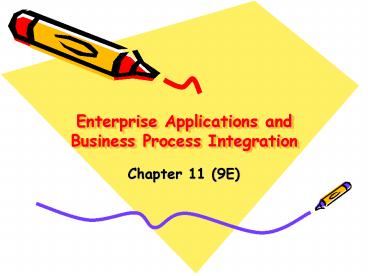Enterprise Applications and Business Process Integration - PowerPoint PPT Presentation
1 / 23
Title:
Enterprise Applications and Business Process Integration
Description:
Intranets and Extranets Play a Major Role in SCM. Figure 11-6. Ovals represent extranet users. ... Business Value of SCM Systems ... – PowerPoint PPT presentation
Number of Views:47
Avg rating:3.0/5.0
Title: Enterprise Applications and Business Process Integration
1
Enterprise Applications and Business Process
Integration
- Chapter 11 (9E)
2
Three Systems
- Our focus is on the following enterprise
applications - Enterprise resource planning systems (ERP
- Supply chain management systems (SCM)
3
What Are Enterprise Systems?
Enterprise System Architecture
4
ERP
- ERP systems are comprised of independent software
modules with a common central database that
support basic internal business processes for
finance and accounting, human resources,
manufacturing and production, and sales and
marketing - The common database enables data to be used by
multiple functions and business process for
precise organizational coordination and control - Process maps are developed by software vendor
that incorporate the best practices for executing
a business process (see next slide)
5
Process Map for Procuring New Equipment
6
Business Value of ERP
- A more uniform organization
- More efficient operations and customer-driven
business processes - Firm wide information for improved decision
making
7
Supply Chain and Supply Chain Management
- A firms supply chain is a network of
organizations and business processes for
procuring raw materials, transforming into
products, and distributing them to customers.
Materials, information, and payments flow through
the supply chain in both directions. - Supply chain management attempts to Coordinate
the business processes to speed information,
product, and fund flows up and down a supply
chain to reduce time, redundant effort, and
inventory costs
8
A Supply Chain
9
Parts of the Supply Chain
- Upstream includes the organization's suppliers
and their suppliers and the process for managing
relationships with them. - Internal supply chain includes process for
transforming the materials, components, and
services furnished by suppliers into finished
goods and for managing materials and inventory - Downstream consists of the organizations and
process for distributing and delivering products
to the final customers
10
Five Major SC Processes
- Planning Balancing demand and supply to meet
sourcing, production, and delivery requirements - Sourcing Procurement of goods and services
needed to create a product or service - Making Processes that transform a product into a
finished state - Delivering Processes to manage order
transportation and distribution - Returning Processes associated with product
returns and post delivery customer support
11
Logistics
- Logistics concerns all factors that will have an
impact on transporting the correct
product/service to where it is needed on time and
at the least cost. - Particularly important in the transportation of
raw materials in the upstream portion of the
supply chain and transportation of finished goods
in the downstream portion of the supply chain. - Logistics counts for 12-14 of a manufacturers
costs
12
Key Supply Chain Management Processes
13
SCM Applications (Systems)
- The primary goal of all supply chain management
systems is to automate flow of information
between company and supply chain partners. - Two major types
- Supply chain planning systems Generate
demand forecasts for a product (demand planning)
and help develop sourcing and manufacturing plans
for that product. - Supply chain execution systems Track the
physical status of goods, the management of
materials, warehouse and transportation
operations, and financial information involving
all parties.
14
Supply Chain Planning and Execution Systems
(Examples)
15
Supply Chain Performance Measurement
- Metrics for measuring supply chain performance
- Fill rate (the ability to fill orders by the due
date) - Average time from order to delivery
- The number of days of supply in inventory
- Forecast accuracy
- The cycle time for sourcing and making a product
16
Intranets and Extranets Play a Major Role in SCM
Ovals represent extranet users.
17
Advantages of Internet SCM Applications
- Provide standard set of tools
- Facilitate global supply chains
- Reduce costs
- Enable efficient customer response
- Allow concurrent supply chains
18
Demand-Driven Supply Chains
- Push-based model Production master schedules
based on forecasts of demand for products, and
products are pushed to customers - Pull-based model Supply chain driven by actual
customer orders or purchases (Dell)
19
Push- versus Pull-Based SC Models
20
Business Value of SCM Systems
- Improved customer service and responsiveness
(product availability) - Cost reduction (supply chain costs represent 75
of operating expenses for many firms reducing sc
costs can have major impact) - Cash utilization (improved cash flows)
21
Challenges of Implementing Enterprise Systems
- High total cost of ownership
- Organizational change requirements
- Realizing organizational goals
- Seventy percent of organizations have not
obtained the promised benefits of enterprise
systems
22
Vendors
- Microsoft (http//www.microsoft.com/dynamics/ax/pr
oduct/supplychain.mspx ) - SAP (SAP United States - Business Management
Software Enterprise Application Integration) - Oracle (http//www.oracle.com/applications/procure
ment/intro.html) - JDA (http//www.jda.com/solutions/strategic-supply
-demand-solutions-overview.html )
23
Why Do Enterprise Projects Fail So Often?
- Enterprise systems software requires people to
adopt new work methods - People often dont agree that the Enterprise
systems way of doing things is better than
existing processes - Either people resist or force IT to customize
Enterprise systems - Customization makes the software unstable and
harder to maintain - The mistake companies make is assuming that
changing people's habits will be easier than
customizing the software. There is a delicate
balance between these two choices. - Extensive collaboration and planning across
functional areas and between firms. - Huge education and training needs.































